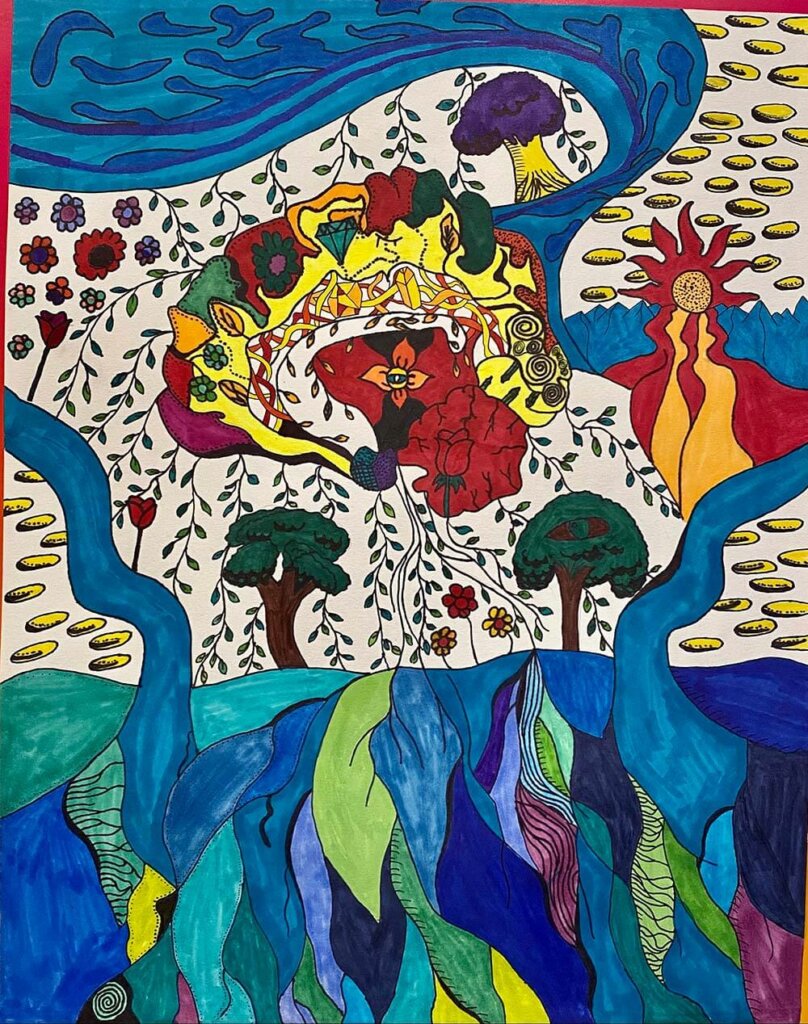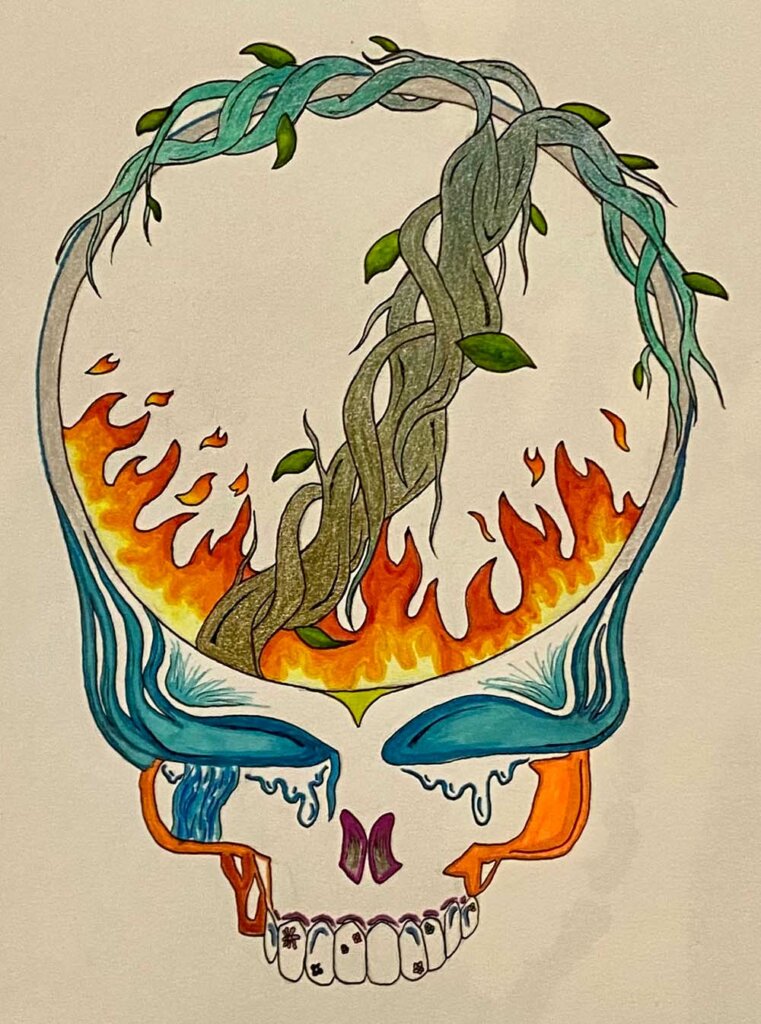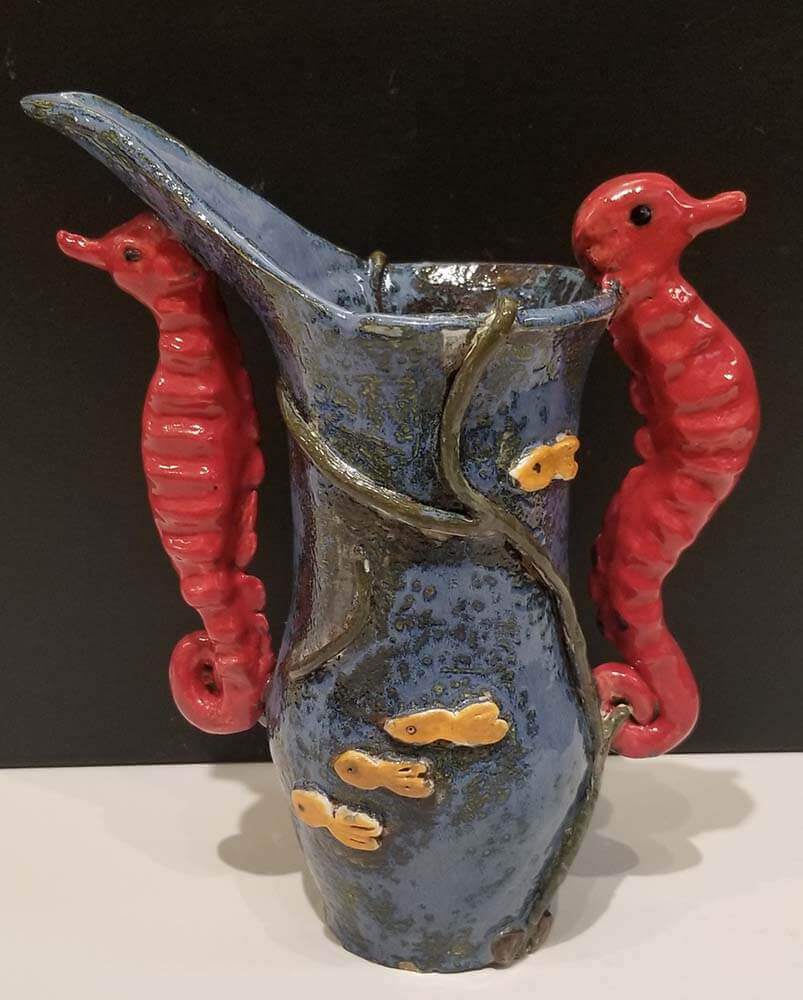News
Digital Winter Visual Arts Exhibition
Poly’s Visual Arts Department is again proud to share a digital Visual Arts Exhibition to showcase a limited selection of works from our in-person Winter Arts Show. With the online platform that debuted in spring 2021, family and friends can experience the talent of our visual arts students no matter where they are located. Galleries include more than 140 pieces of Middle and Upper School artwork that capture a wide array of mediums including painting, drawing, ceramics, sculpture, and photography.
Advanced Drawing Collections
Students in our Advanced Drawing courses never cease to amaze with their level of skill. Under the purview of Dan Herwitt, works by students showcase the imagination, creativity, and illustrative prowess of Upper School artists.
AP Drawing
The AP Drawing course focuses on concepts and skills emphasized within college art and design foundations courses with the same intent: to help students become inquisitive, thoughtful artists and designers.
Advanced Drawing: Grateful Dead Stealie
One of the most iconic symbols in rock music, Dan Herwitt charged his students with creating their own vision of the Grateful Dead “Stealie.” Originally designed by Owsley “Bear” Stanley and Bob Thomas, the Grateful Dead “Stealie” symbol is synonymous with freedom and rebellion.
“Since we were given free range of what to do in terms of design,” said Brianna Kwan ’23, “it was hard to decide on what to draw. I knew I wanted to keep the general structure of the skull, but didn’t know how to put my own spin to it. I had an idea of changing the iconic lightning bolt into a thick vine resembling a beanstalk, and from there I decided to stick with a nature theme. The green of nature is expressed through the flowers embellishing the teeth and the vine growing onto the outer lining of the skull. The fire aspect is in the inner part of the circle with an ombre ‘burning’ the bottom part of the vine, hence the difference in color throughout the vine. Water is mainly in the eyes, and I thought of making the lines on the original skull to be a waterfall, pouring out tears. After that, there was space left in the face area so I decided to ditch technicality and doodle random shapes and patterns.”
“The most fun part about this piece,” said Kwan, “was changing my plans for it while I was creating it and adding more elements to make the piece look fuller and cohesive. I really like the last minute addition of the drips under the eye because they give the work an edge to it, especially with the shadows.”
Scientific Illustrations
The art of scientific illustration is beautifully depicted by students in Dan Herwitt’s class. Paying close attention to texture and form, as well as using technical pens to produce intricate fine lines and varied gradients, students wowed us with their bird drawings. We think David Allen Sibley and John James Audubon would be impressed.

For their skull illustrations, students focused on tonality and form, along with the use of detail and negative space, and looked at artists such as Tiffany Bozic and John James Audubon. For many, this was their first foray using professional mechanical pencils to produce fine detail.
Art of Design Collections
The beauty of product design is all around us. A new addition to Visual Arts’ course offerings is Paola Ligonde’s Art of Design classes where students learned to conceptualize and create a product from start to finish.
Middle and Upper School Product Design
Middle and Upper School students explored the beauty of product design. As consumers, there are logos or aesthetics we expect from brands – think Apple or Nike, for instance. For designers, the hope is to create logos, branding, aesthetics that are appealing, memorable, and tell a story to the consumer. With that in mind, in these projects, our students ventured to research a consumable product, artisanal butter, and design covers of sketchbooks. Upper School students conceptualized, mapped out, and designed stationery sets. They used unfamiliar mediums and considered not only design, but how they’d advertise their work.
Visit the galleries:
Ceramics Collections
Beginner and more advanced Ceramics students captured our imaginations with their pottery works under the guidance of Poly’s clay master, Yonghwi Kim. They employed various techniques of the ancient art form such as the slab and coil methods, as well as wheel-thrown works. The projects tell stories and draw inspiration from nature, Native American works, and China, and incorporate texture, patterns, glazes, and color to create their pottery. They also looked at form and function and the result was a celebration of ceramics that ranged from vases to teapots to sculpture.
Visit the galleries:
- Decorative Pitchers
- Native American Inspired Pottery
- Sculpture
- Vases with Organic Textures
- Wheel Thrown Pottery
- Yi Xing Teapots
“I am a beginner at wheel throwing,” explained Giulio Basilico ’23, “and I was trying to make things that would be useful or making what Mr. Kim was teaching us to make. My favorite part of the projects was seeing them after they had been fired for the last time. I was really happy with how the shapes and colors came out for them.”
Foundations Studio Art

Students in our Foundations courses use a variety of media to express themselves through drawing, painting, and printmaking. Here, they build necessary skills and introduce historical context that gives students a deeper sense of creative potential and practice to ignite their imaginations.
Foundations in Drawing: Brainscapes
Part biological landscape, part self-reflection, Dan Herwitt asked his students to create a portrait of their “internal light and think of themselves as a mirror of their passions” using pens and markers.
Ashi Malhotra ‘25 said she was inspired by retro artwork and modern patterns. “The most challenging thing was the creative aspect on what to do inside and outside the brain,” Malhotra said. “Definitely the most fun thing about making the brainscapes was the freedom I had making this.”
Introduction to Drawing, Painting & Printmaking: Surrealism Meets Self-Portraiture
At the Metropolitan Museum exhibition Surrealism Beyond Borders, Adina Scherer’s students drew inspiration to create their own two-panel self-portraits.
“The inspiration for my work,” said Skye Ava Rosario ’24, “was the things that interest me and make up who I am. When painting/drawing/printing myself, I tried my best to make an accurate self-portrait and then tried to fill the background with things that make me me.”

Middle School Collections
Studio Art Grades 5&6 and 7&8
In Helena Elko’s Studio Art classes, creativity and collaboration were the name of the game. Grades 5&6 students worked in groups to conceptualize and create a landscape sculpture using unconventional materials while students in Grades 7&8 focused on observation and drawing techniques to bring out the glory of gourds for their still lifes. For their “Faces” project, students explored colors and mediums to vividly unique self-portraits.
“Something that inspired our work,” explained Max S. ’29, “was the beautiful scenery of the whole entire town, and we wanted it to come alive in our piece.”
“For the pumpkin still-life project,” Justin W-O. ’27 said, “the main inspiration for me was the way I learned how to shade objects and do contour line drawing. If I didn’t know how to do these two things, I would not have been able to do the project. I also got inspiration from the two unique-looking pumpkins I had in front of me.”
Photography Collections
Photography is all around us – including in our pockets and bags thanks to mobile phones. This ubiquitous art form gives everyone the ability to effortlessly capture a scene or subject. The talented students in Adina Scherer’s classes have honed their skills using a DSLR camera, learning techniques like framing a shot and subject composition, lighting, and diving into the digital editing arena of Photoshop, the industry standard for image editing. The result of their efforts and attention are the stunning photos shared with us that exemplify a broad skill set and creative aesthetic.
“Each of my photographs was inspired by different things,” explained Violet Taub ’24. “I absolutely love sunsets and how beautiful the sky can get, so that’s why that scenery caught my eye while riding the bus home, and I had to take a picture of it. I am also a huge fan of dark pictures because I feel as though they can be interpreted in many different ways. Some of the photos I took that are in the show are definitely pretty dark and they stand out… I really loved how open-ended this assignment was…”
“While walking home from the bus,” Zoe Campbell ’25 explained, “I was inspired by the beautiful scenery around me, which prompted me to pull out my camera and take some pictures. In my work, I like to focus on street photography, and I try to capture the ordinary moments in my neighborhood.”
“Getting the lighting right in every picture was the most challenging part for me,” Campbell added. “Other than that, I really enjoyed learning how to use the camera, and how to better edit my photos through Photoshop.”
Visit the Photography galleries:

Art & Social Change Collections
It’s difficult to imagine a more compelling artistic endeavor than the melding of visual arts and contemporary issues that span a variety of subjects and can ignite individual passion. Activism, identity, politics, ethnicity, class, sexism, racism, social justice, and others, often feed social transformation through the sheer passion, grit, and creativity of the artist. The works found in Laura Coppola’s class galleries, Proposing Social Change at Poly and Weaving a Self-Portrait do just that. Coppola’s students were inspired by diverse, contemporary artists, all of whom have left an indelible, uncompromising mark on the artworld.
Proposing Social Change at Poly
“Something that inspired me to create this project,” Charlotte Bonthrone ’25 said, “were the encouraging posters [such as posters about body positivity] hung around the school. I believed it was an important issue that must be represented throughout the Poly community.”
“One of the most fun things I experienced while creating this project,” Bonthrone said, “was brainstorming what we could add to the school campus in order to help empower the students to feel more comfortable and confident in their own skin.” “Poly is known for its beautiful campus,” Oakley DeCristofaro ’25 said. “Gorgeous greenery and trees are dispersed throughout the campus, there are a few ponds, and it is on 25 acres. There is only one thing wrong with it: it is not accessible to those with physical disabilities. What inspired me was the fact that many of my friends (including me) were athletes and if any one of us got hurt and had to be on crutches or even a wheelchair it would be extremely hard for us to get around the campus. Not only that, but there are little to no people that go to Poly that have a physical disability. For this project I took a picture of one of the staircases on campus and water colored that photo onto a piece of paper. My whole point was that students would be able to learn how to make a ramp using certain materials and they would get service hours while doing so. That way, students who have a physical disability could easily get from one place to another, allowing Poly to be more diverse and be a home to all different students.”
Weaving a Self-Portrait
“For this project,” Oakley DeCristofaro ’25 explained, “we were told to create something relating to a part of our social identity: I decided to focus on my Jewish identity. It was the first thing that popped into my mind, as it was something unique about myself. My connection to Judaism is reflected in the composition of my piece because I included a drawing of me at my Bat Mitzvah and I chose specific colors that I thought would accurately depict my Jewish heritage. I split up the images, text, and self portrait that I wanted to incorporate in my piece and wove them through fabric to represent how Judaism is woven through my life. When creating this piece, at times I struggled to make the weave turn out how I wanted it to. It was hard to get the exact stitch to fit into place, which sometimes became frustrating. Despite the difficulties I had in the process, I like how this piece turned out and I am very proud of the result.”










